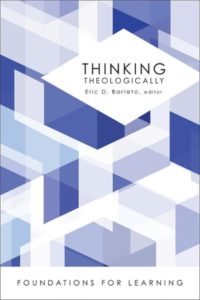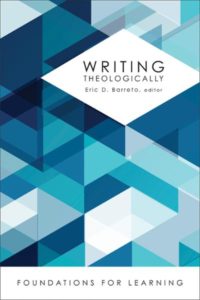

Thinking Theologically and Writing Theologically
Thinking Theologically. Edited by Eric D. Barreto. Minneapolis, MN: Fortress Press, 2015, 100 pp. $14.00.
Writing Theologically. Edited by Eric D. Barreto. Minneapolis, MN: Fortress Press, 2015, 157 pp. $14.00
Reviewed by Melissa A. Martin
In second grade I had a teacher who loved United States history. Her love eventually led me to believe that even I could play a part in U.S. government. I found a similar love in Thinking Theologically and Writing Theologically, two books in Fortress Press’s recent “Foundations For Learning” series. The “Foundations for Learning” series seeks to introduce first-year seminary students or those considering seminary to the “skills, practices, and values to succeed in seminary” (http://fortresspress.com/foundations). However, these books are not just about skills or values. These two volumes are about “in-formation”—“forming” the readers with knowledge and practices and “in”spiring them with love for the tasks at hand.
According to Eric D. Barreto, the editor of these two volumes and now the Weyerhaeuser Associate Professor of New Testament at Princeton Theological Seminary, these volumes harmonize the reflections of a diverse group of writers. The members of this diverse group not only exhibits excellent scholarship and promise in their given fields (some outside of the academy), but they all “share a common vocation: teaching people … to think and grow and be in a rapidly changing world for the sake of the good news of Jesus Christ” (Thinking Theologically, 3).
Writing Theologically begins by explaining the basics: how to write a paper. In the first chapter, “Writing Basically,” contributor Richard Newton carefully explains how to write a critical essay. Yet his thesis is not just about writing a good essay—he reviews the basics to prepare himself and his audience to “express the word residing within us” (6). For Newton and the rest of the contributors, writing itself is a theological task. Barreto explains, “When we communicate our ideas clearly and persuasively and passionately, we answer the high call to be proclaimers of the good news of Jesus Christ” (1–2). While Newton outlines the basics, the next four chapters offer different methodological approaches to writing: “Writing Persuasively,” by David G. Garber Jr.; “Writing for the Ear,” Karyn L. Wiseman; “Writing Briefly,” Shively T. J. Smith; and, “Writing Creatively,” Angela Yarber. These chapters each include a biblical or theological justification for their respective approach and steps that the reader can take as they begin (or continue) on the writing journey. Then come three chapters that approach writing not just methodologically but by forefronting the needs of the modern audience: “Writing Publicly,” Grace Ji-Sun Kim; “Writing Digitally,” Adam J. Copeland; and, “Writing Purposefully,” Melinda A. McGarrah Sharp. For each of these authors, writing is an expression of love of neighbor. Not forgetting love of the self, this volume concludes with two chapters, “Writing Personally” (Raj Nadella) and “Writing Spiritually” (Jacob D. Myers), both of which explore the effect that writing has on writers themselves.
While Writing Theologically starts with the basics of writing an essay and ends with the effect writing has on the writer as an individual, Thinking Theologically begins with understanding the individual as the thinker. Rejecting any mandated pattern of thinking and pushing beyond a mind-body dualism, the first two chapters—“Thinking Mindfully” (Jennifer M. Shepherd) and “Thinking Bodily” (Lance J. Peeler)—call the readers to self-awareness, which will then allow them to love God and others through the way that they think. The following four chapters address the areas of thinking specific to the disciplines encountered during a seminary education: “Thinking Pastorally,” Jessicah Krey Duckworth; “Thinking Biblically,” Mariam J. Kamell; “Thinking Historically,” Adam Ployd; and, “Thinking Systematically,” Amy Marga. Each of these chapters engage their respective disciplines by imploring their readers to see their acts of thought not just as cerebral acts but as spiritual acts. Then, Maltide Moros in “Thinking Ethically” and Stephanie Buckhanon Crowder in “Thinking Socially” push the boundaries of thought outside the cerebral and into the spiritual by overtly emphasizing that thinking and action must go hand in hand. For Crowder, this action is a public action that takes place in the technological sphere. Claudio Carvalhaes concludes this volume with “Thinking Spiritually,” which connects the thread and takes us back to the first concept in this chapter “thinking bodily.” Carvalhaes reinforces the fact that theological thinking, shaped by our bodies and experiences, is an act of loving God and knowing oneself to be loved. He writes, “My hope is that you will perceive how you love and are loved” (132).
At the outset, it seems strange that Carvalhaes would feel the impulse to reiterate that he hopes the reader will perceive that they are loved. Yet imposter syndrome and fear cloud the minds of many seminarians, both new and old. In these volumes, the contributors address those fears, offering comfort. In doing so, the contributors also counter an ivory tower approach to a theological education. Their diversity, vulnerability, and encouragement to their audience to see their own experience as a resource help to overcome any myth of homogeneity in theological education, addressing imposter syndrome at its very root.
As such, both volumes are helpful for their intended audience. Thinking Theologically sets up a helpful theoretical foundation, a foundation that may be best introduced by reading a book like this before arriving to seminary. While preparing for seminary, the reiterated message in this volume could serve as a comfort to the readers instead of a point of disengagement. With more practical steps, Writing Theologically might be best used as students are setting their rhythms at seminary and beginning to write papers. Similar to Thinking Theologically, the chapters in Writing Theologically feature some repetition. In both cases, this repetition can be used to reinforce the message: that the skills, practices, and values the contributors describe are important—but even more so, that the reader is loved. As introductory “in-formation” these volumes are an excellent choice. They demonstrate a love and care that will help set a firm foundation and inspire new seminary students.
Melissa A. Martin, MDiv/MACEF Candidate, Princeton Theological Seminary
